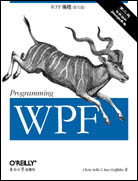
WPF编程(第二版,影印版)
出版时间:2008年05月
页数:835
“本书十分全面深入地剖析了WPF。Chris和Ian阐释和构建软件的独特方式照亮了每一个角落并且充分展现了平台的全貌。当他们碰到它的缺点时,不会马上解释,而是向你展示如何应付它们,如何解决实际问题。”
——Chris Anderson,原Windows Presentation Foundation架构师
“这些年来,我非常幸运地与Chris Sells就WPF的细节有过多次对话——有些时候通过电话,有些时候在他的办公室里(在我办公室门前走廊的另一端),有些时候在牌桌上……本书教会我很多东西。”
——Don Box,微软架构师
这本书的设计初衷是让你快速掌握微软Windows Presentation Foundation,如果想要构建完全利用Windows Vista和Windows XP用户界面潜能的应用程序,这就是一项你需要学习的技术。读到第二页,你将会编写一个简单的WPF应用程序。第一章结束时,你就已经遍览了WPF的主要元素。
这本《WPF编程》第二版根据WPF正式发布版更新,包括了导航、文本与文档、打印与XPS以及3D图形等主题,还有一个新的附录,涵盖了微软近期发布的用于通过标准Web浏览器传递丰富用户界面的Silverlight平台——其与Adobe Flash十分相似。第一版中的内容已被大量扩展和修改,此外本书还包括:
* 众多C#和XAML范例,从简单的“Hello,Avalon”到“井”字游戏,向你展示用什么可以让一个WPF应用程序启动并运行
* 关于WPF带给Windows开发强大的新编程风格的极富见地的讨论,特别是它的新控件模型
* 讲解颜色插值,以更好地阐释WPF对3D、颜色以及其他图形效果的支持
* XAML教程,即介绍声明Windows UI的新的类HTML标记语言
* 说明并比较Windows Form与其他旧Windows应用程序支持的互操作特性
WPF代表了基于控制的Windows和基于内容的Web这两大世界中的最先进技术。《WPF编程》帮助你将它们结合在一起。
——Chris Anderson,原Windows Presentation Foundation架构师
“这些年来,我非常幸运地与Chris Sells就WPF的细节有过多次对话——有些时候通过电话,有些时候在他的办公室里(在我办公室门前走廊的另一端),有些时候在牌桌上……本书教会我很多东西。”
——Don Box,微软架构师
这本书的设计初衷是让你快速掌握微软Windows Presentation Foundation,如果想要构建完全利用Windows Vista和Windows XP用户界面潜能的应用程序,这就是一项你需要学习的技术。读到第二页,你将会编写一个简单的WPF应用程序。第一章结束时,你就已经遍览了WPF的主要元素。
这本《WPF编程》第二版根据WPF正式发布版更新,包括了导航、文本与文档、打印与XPS以及3D图形等主题,还有一个新的附录,涵盖了微软近期发布的用于通过标准Web浏览器传递丰富用户界面的Silverlight平台——其与Adobe Flash十分相似。第一版中的内容已被大量扩展和修改,此外本书还包括:
* 众多C#和XAML范例,从简单的“Hello,Avalon”到“井”字游戏,向你展示用什么可以让一个WPF应用程序启动并运行
* 关于WPF带给Windows开发强大的新编程风格的极富见地的讨论,特别是它的新控件模型
* 讲解颜色插值,以更好地阐释WPF对3D、颜色以及其他图形效果的支持
* XAML教程,即介绍声明Windows UI的新的类HTML标记语言
* 说明并比较Windows Form与其他旧Windows应用程序支持的互操作特性
WPF代表了基于控制的Windows和基于内容的Web这两大世界中的最先进技术。《WPF编程》帮助你将它们结合在一起。
- Forewords
- Preface
- 1. Hello, WPF
- WPF from Scratch
- XAML Browser Applications (XBAPs)
- Content Models
- Layout
- Controls
- Data Binding
- Dependency Properties
- Resources
- Styles
- Animation
- Control Templates
- Graphics
- 3D
- Documents and Printing
- 2. Applications and Settings
- Application Lifetime
- Application Deployment
- Settings
- 3. Layout
- Layout Basics
- StackPanel
- WrapPanel
- DockPanel
- Grid
- Canvas
- Viewbox
- Common Layout Properties
- When Content Doesn’t Fit
- ScrollViewer
- Custom Layout
- 4. Input
- Routed Events
- Mouse Input
- Keyboard Input
- Ink Input
- Commands
- Code-Based Input Handling Versus Triggers
- 5. Controls
- What Are Controls?
- Buttons
- Slider and Scroll Controls
- ProgressBar
- Text Controls
- ToolTip
- GroupBox and Expander
- List Controls
- Menus
- Toolbars
- GridSplitter
- 6. Simple Data Binding
- Without Data Binding
- Data Binding
- Debugging Data Binding
- 7. Binding to List Data
- Binding to List Data
- Data Source Providers
- Master-Detail Binding
- Hierarchical Binding
- 8. Styles
- Without Styles
- Inline Styles
- Named Styles
- Element-Typed Styles
- Data Templates and Styles
- Triggers
- 9. Control Templates
- Beyond Styles
- Logical and Visual Trees
- Data-Driven UI
- 10. Windows and Dialogs
- Window
- Dialogs
- 11. Navigation
- NavigationWindow
- Pages
- Frames
- XBAPs
- Navigation to HTML
- 12. Resources
- Creating and Using Resources
- Resources and Styles
- Binary Resources
- Global Applications
- 13. Graphics
- Graphics Fundamentals
- Shapes
- Bitmaps
- Brushes and Pens
- Transformations
- Visual Layer Programming
- 14. Text and Flow Documents
- Fonts and Text Styles
- Text and the User Interface
- Text Object Model
- Typography
- 15. Printing and XPS
- XPS
- XPS Document Classes
- Generating XPS Output
- XPS File Generation Features
- System.Printing
- Displaying Fixed Documents
- 16. Animation and Media
- Animation Fundamentals
- Timelines
- Keyframe Animations
- Path Animations
- Clocks and Control
- Transition Animations
- Audio and Video
- 17. 3D Graphics
- 3D Content in a 2D World
- Cameras
- Models
- Lights
- Textures
- Transforms
- 3D Data Visualization
- Hit Testing
- 18. Custom Controls
- Custom Control Basics
- Choosing a Base Class
- Custom Functionality
- Supporting Templates in Custom Controls
- Default Styles
- UserControl
- Adorners
- A. XAML
- B. Interoperability
- C. Asynchronous and Multithreaded WPF Programming
- D. WPF Base Types
- E. Silverlight
- Index
书名:WPF编程(第二版,影印版)
作者:Chris Sells, Ian Griffiths 著
国内出版社:东南大学出版社
出版时间:2008年05月
页数:835
书号:978-7-5641-0838-0
原版书出版商:O'Reilly Media
The animal on the cover of Programming WPF, Second Edition, is a kudu. Not to be
confused with kudzu (a purple-flowered vine indigenous to East Asia), the kudu,
native to East Africa, comprises 2 of the 90 species of antelope: lesser kudu (Tragelaphus
imberbis) and greater kudu (Tragelaphus strepsiceros). Both species have coats
of a brownish hue, adorned with white stripes and spots, and a crest of long hair
along the spine. Their coloring and markings help camouflage them from predators
including big cats, wild dogs, eagles, hyenas, and pythons. If alarmed, kudus will
stand very still, making them virtually impossible to spot.
Kudu males are easily distinguished from their distaff counterparts by their twisted
horns, whose myriad traditional applications among African cultures include serving
as musical instruments, honey receptacles, and ritual symbols of male potency.
Males sometimes form small bachelor groups but more often remain solitary and
widely dispersed. Dominance is usually established quickly and peacefully by means
of a lateral display, in which one male kudu stands sideways in front of another,
making himself look as large as possible. Males only join females during mating
season. Female kudus leave their newborns for four or five weeks after birth, but the
calves eventually accompany their mothers, forming small groups of 6–10 females
and offspring. Calves grow rapidly and are fairly independent by six months of age.
confused with kudzu (a purple-flowered vine indigenous to East Asia), the kudu,
native to East Africa, comprises 2 of the 90 species of antelope: lesser kudu (Tragelaphus
imberbis) and greater kudu (Tragelaphus strepsiceros). Both species have coats
of a brownish hue, adorned with white stripes and spots, and a crest of long hair
along the spine. Their coloring and markings help camouflage them from predators
including big cats, wild dogs, eagles, hyenas, and pythons. If alarmed, kudus will
stand very still, making them virtually impossible to spot.
Kudu males are easily distinguished from their distaff counterparts by their twisted
horns, whose myriad traditional applications among African cultures include serving
as musical instruments, honey receptacles, and ritual symbols of male potency.
Males sometimes form small bachelor groups but more often remain solitary and
widely dispersed. Dominance is usually established quickly and peacefully by means
of a lateral display, in which one male kudu stands sideways in front of another,
making himself look as large as possible. Males only join females during mating
season. Female kudus leave their newborns for four or five weeks after birth, but the
calves eventually accompany their mothers, forming small groups of 6–10 females
and offspring. Calves grow rapidly and are fairly independent by six months of age.
购买选项